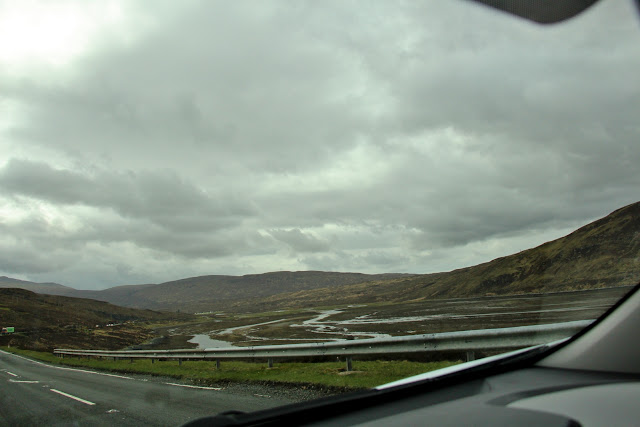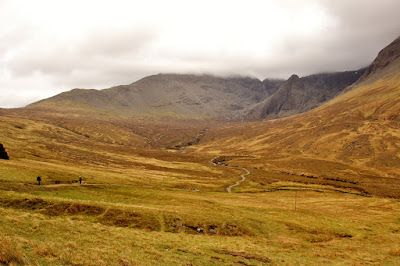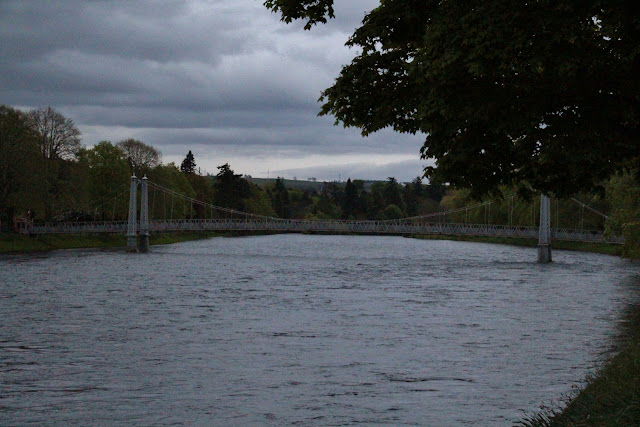Originally for this day, we had planned to stay closer to Inverness and explore the surrounding towns, but every time we told someone that we were planning to travel up to Inverness, they asked us if we were planning on heading out to the Isle of Skye as part of our trip. The more and more we were asked this, the more I wanted to go. So, we did our fair share of googling and decided that we could make a day of it and at least see part of Skye as well as some other spots along the way to the island.
 |
| Urquhart Castle |
- Our first stop for the day was at the ruins of Urquhart Castle (pronounced ur-kurt), which was just 30 minutes south of Inverness on the shores of Loch Ness. We were told that some sort of fortification had stood on this spot since medieval times, but Urquhart Castle itself didn't come into existence until the 13th century. Subsequent fighting over its position between the English and the Scots and the different Scottish clans themselves formed the history of this castle. But ultimately in the 1690s, the garrison of soldiers held the castle against a force of Jacobites, but as the soldiers left, they blew up the gatehouse to prevent any reoccupation by the Jacobites. Since then it was plundered for the stonework and subject to the whims of the weather, leaving it to be the ruins that exist today. Even though there isn't a whole lot left to see, it is one of Scotland's most visited castles. Being situated on the shores of Loch Ness makes it a very picturesque place for photogs (myself included), and we were able to climb up to the top of what remains of the Grant Tower for a pretty spectacular view. Although you can't see it very well from the pictures here, the hills surrounding the castle were covered in big yellow flowering bushes of ulex (aka, gorse or whin). They were everywhere in the Highlands and really the first signs of spring/summer that we were able to see.






 |
| Eilean Donan Castle at low tide |
- After leaving Urquhart Castle, we turned our pathway west and headed towards Kyle of Lochalsh to visit Eilean Donan Castle and then make our way across the bridge to the Isle of Skye. We had a really nice drive, saw some deer along the way, and just enjoyed all the scenery. Now, Eilean Donan may be one of the most photographed castles in the world, but what those photos don't tell you is that this castle isn't even a hundred years old yet! Located where three sea lochs meet, the island has always been a strategic location for defense. The original castle was started in the 13th and 14th centuries and continually built and rebuilt to fortify it. It changed hands and purposes a number of times until in 1719 a small garrison of Spanish soldiers held it for the Jacobites who were hoping to restore Bonnie Prince Charles to the throne. Government ships bombarded the castle forcing the Spanish soldiers to surrender, and the British were sent ashore to blow up what remained of the castle, including the 343 barrels of gunpowder. (Why people keep blowing up casltes, I don't know...). Fast forward 200 years, and Lt. Col John MacRae-Gilstrap and Farquhar MacRae spent 20 years rebuildling the castle using materials from the surrounding areas of Scotland to restore the castle for the MacRae family. It was said to cost them a quarter of a million pounds to complete. After touring the outside grounds, you can go into the castle itself for a tour (sorry, no pictures allowed). The castle boasts a banqueting hall which houses many family items and Jacobite artifacts, bedrooms on the third floor to tour, the kitchen, and many hidden walks and rooms. We really enjoyed visiting this castle and seeing the family pride built into it.






 |
| Driving around the Isle of Skye |
- Most of the islands off the coast of Scotland are only accessible by ferry, but in 1995, they opened a bridge up that connects the Isle of Skye to the mainland and saving us some time in getting there. Once we filled up at the last gas station before the bridge and had a nice chat with the operator, we were ready to embark on our next driving adventure. There were definitely no motorways on Skye. In fact, when I asked the gas station operator what the closet city was to the Fairy Pools so I could put it in the SatNav, she just laughed and said Skye has no cities. What I should've said was towns or villages because that's mainly what we drove by every so often. Little clusters of maybe 10 to 20 houses at a time - mostly fishing villages along the coasts. I was able to finally get a cell signal though once across the bridge and pull up instructions on how to get to the Fairy Pools. The road there took us in and out of the coastline and then farther and farther up into the mountain ranges. We passed plenty of livestock, mostly sheep, and we even happened upon a herd of Highland Coos (cows), who were very kindly posing on top of a hill for passersby to snap photos. Once we got to right outside the village of Carbost, we had to turn onto a B road to go further up into the Black Cuillin hills where the Fairy Pools were located. Fun fact about driving on B roads - they're not fun. They're one lane roads with "passing places" for oncoming traffic to pull off and wait for others to go by. They're even more unnerving when you're driving one up a hillside and really can't see the oncoming traffic. Luckily, we weren't on a heavily traveled road. We even had to cross a couple of cattle guards on our way, which was odd because here in Texas if you're crossing a cattle guard, you're on someone's private property. But not in Scotland!




 |
| The hike out to the Fairy Pools |
- Now, we hadn't had the clearest of days on Wednesday, but that did not deter us or the dozens of other hikers we encountered upon arrival at the Fairy Pools. While we picked to go here on a whim, it's apparently a particularly high traveled spot on the island and is crazy busy during the summer season. On the day we visited, it was cloudy, windy, and in the 50s, so spring hadn't exactly come to this part of Scotland yet. I imagine that if we had gone a few weeks later, we'd have seen something completely different as more snow from the mountains would have melted filling the pools even more and more flowers would have started blooming on the moors. And if it had be sunny, the pools would've been a crystal blue. Still, these wonders of nature did not disappoint. It was roughly a 1.5 mile hike through the moors out to the Fairy Pools with varying inclines and water crossings to jump over (ok, jump for me; step for Kevin...oh, to have longer legs). The pools are formed by the melting snow coming down from the Black Cuillin hills into the River Brittle that flows through the moor. While suitable for swimming, the pools range from cold to absolutely freezing, and we weren't about to jump in. But the views were gorgeous and that's what we had come to see.










 |
| Inverness Castle |
- The hike back ended with a long uphill climb, and my short little legs were pretty much tired out by the time we got back to the car. We stopped by the food truck that was camped out in the car park, grabbed some chicken wraps, and took a minute to warm up before we headed back to Inverness for the night. Seeing that the sun didn't set til almost 10, by the time we got back to Inverness, we still had some time to walk around down by the River Ness that flows through the center of town. It was a nice way to end the day. While it seems like we spent a good part of our day in the car, we ended up walking just over 7.24 miles, or 17,637 steps. We even saw Inverness Castle, which is now a government building, that was built in the 1830s and 40s on top of the hill on which previous castles defenses stood. It may not have been quite like seeing Macbeth's castle, but it still had an air of stateliness to it. The River Ness was only about 5 feet deep, but it moved a pretty good clip and was quite chilly.



- Along the walk by the River Ness, we took a moment and stopped by the town's WWI monument and memorial park. Every town and village of note that we visited had its own WWI monument with its red poppy memorial wreaths. The red poppy was found on the battlefield of Flanders and inspired Canadian doctor, Lt. Col. John McCrae to write the poem "In Flanders Fields," which then in turn became a national symbol of remembrance and hope. The number of memorials scattered across the countryside was a stark reminder of the high numbers of men that the UK lost at home and abroad.
"IN FLANDERS FIELDS"
In Flanders
fields the poppies blow
Between the
crosses, row on row,
That mark our
place, and in the sky,
The larks,
still bravely singing, fly,
Scarce heard
amid the guns below.
We are the
dead; short days ago
We lived, felt
dawn, saw sunset glow,
Loved and were
loved, and now we lie
In Flanders
fields.
Take up our
quarrel with the foe!
To you from
failing hands we throw
The torch; be
yours to hold it high!
If ye break
faith with us who die
We shall not
sleep, though poppies grow
In Flanders fields.




